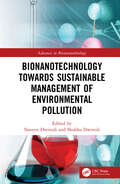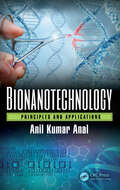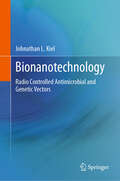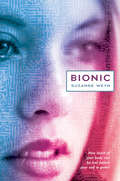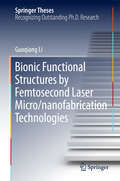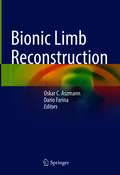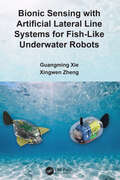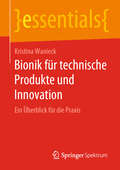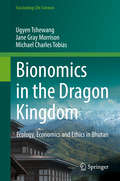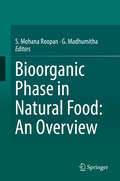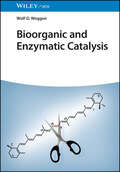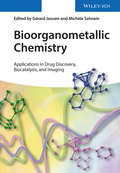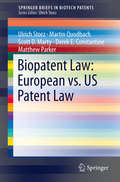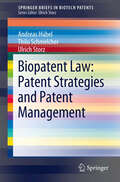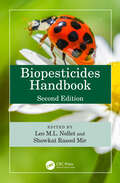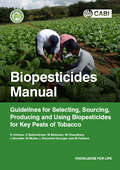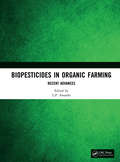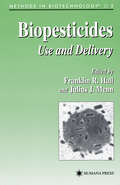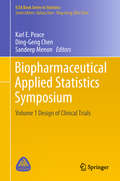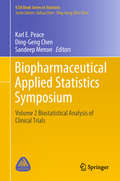- Table View
- List View
Bionanotechnology Towards Sustainable Management of Environmental Pollution (Advances in Bionanotechnology)
by Naveen Dwivedi Shubha DwivediThis book highlights the characteristics, aims, and applications of bionanotechnology as a possible solution for sustainable management and bioremediation of environmental pollutants. It covers remediation of toxic pollutants, removal of emerging contaminants from industrial wastewater, eco-design and modification study of bio-nanoparticles and life-cycle assessment, nano-filtration, bio-nanomaterials based sensors for monitoring air and water pollution, resource recovery from wastewater, and highlights Internet of things-based green nanotechnology.Provides a comprehensive solution of environmental problems in sustainable and cost-effective modeReviews bionanotechnological applications in nanomaterials design, modification, and treatment of emerging contaminants from industrial wastewater.Covers Eco-design study of bio-nanomaterials, bio-nano filters, and assessment for the treatment of emerging pollutantsIncludes IoT- based bionanotechnologyExplores future research needs on bionanotechnology and scientific challenges in the mitigation of environmental pollutantsThis book is aimed at researchers, professionals, and graduate students in nanobiotechnology, environmental engineering, biotechnology.
Bionanotechnology for Advanced Applications (Advances in Bionanotechnology)
by Ajaya Kumar Singh Bhawana JainThis book provides the fundamental aspects of bionanomaterials and bionanotechnology, and insight into the synthesis and modification of bionanomaterials in a detailed manner. It initiates with a general overview of biotechnology and nanotechnology followed by different strategies and methodologies for the synthesis of nanomaterials. Further, it discusses pertinent topics such as protein engineering, analysis, mechanisms of microbe- mediated nanosynthesis, followed by various challenges and innovation strategies, and the role of enzymes in bionanotechnology.Features: Covers the synthesis of bionanomaterials, including the interaction between nanomaterial and biogenic materials Encompasses the study of the connections between structure, molecular biology, and nanotechnology Explains several techniques (XRD, SEM, TEM, etc.) used for the analysis of bionanomaterials Includes prospects, challenges, and opportunities associated with bionanotechnology Reviews the interaction between nanomaterials and the biological system and self- assembly in bionanotechnology This book is aimed at graduate students and researchers in materials sciences, biotechnology, and bionanotechnology.
Bionanotechnology: Global Prospects
by David E. ReisnerAs the impact and importance of nanotechnology continues to grow, nanomedicine and biotechnology have become areas of increased development. Drug delivery by nanoparticulates and nanocoatings for medicial devices are among the many new techniques on the horizon. Years from now we will laugh at the approaches to treating disease we currently conside
Bionanotechnology: Principles and Applications
by Anil Kumar AnalThis book deals with a subject of high interest and importance in all sectors, including biomedical, food, agriculture, energy, and environment. Biological systems are essential in nanotechnology, and many new applications are being developed by mimicking the natural systems. Approaching these topics from an engineering perspective, the book offers insight on the details of nanoscale fabrication processes as well as cell biology. The basics of biology and chemistry, with a focus on how to engineer the behavior of molecules at the nanoscale, are also explored and analyzed. The aim of the text is to provide the reader with broader knowledge of biological methods for signal transduction and molecular recognitions systems and how they can be replicated in bio-sensing applications. The reader will learn the basic structures and interactions of biomacromolecules for developing biocompatible and eco-friendly devices.
Bionanotechnology: Radio Controlled Antimicrobial and Genetic Vectors
by Johnathan L. KielThis book describes how methodologies in biochemistry, molecular and cellular biology, electromagnetic bioeffects, and nanotechnology were brought together to construct a nanostructure that is a composite of nucleic acid, carbon nanotube, paramagnetic metallic nanoparticles, and aromatic polymer that is responsive to nonionizing electromagnetic radiation, RFR to microwaves. It demonstrates that the construct can act as a redox catalyst accelerated by nonionizing electromagnetic radiation, and also as a conveyor of genetic modification of specifically targeted eukaryotic and prokaryotic cells. The scientific knowledge necessary to accomplish this is described and step-by-step progress supported by data and examples are noted. The general purpose is to show how such interdisciplinary approaches can lead to disruptive technologies. This book is most valuable to those (molecular biologists, vaccinologists, biomedical engineers, microbiologists) looking for more externally controllable gene vectors, antimicrobials, and antiparasitics, using a totally new nanoparticle platform. Those pursuing biological applications of nanotechnology will also be interested. This text has uniquely multidisciplinary approaches, drawing together chemistry, physics, molecular biology, biochemistry, and biomedical and electrical engineering.
Bionic (Scholastic Press Novels)
by Suzanne WeynMira has always almost had it all... until it all crashes and burns. She's hurt in a horrible car accident, and the only way the doctors can help is to try experimental prosthetics and chips that are implanted directly into her brain. It's a huge risk, but after months of testing and therapy, Mira is back, and better than ever. But soon her friends turn against her as their parents call her on unfair advantages and get her cut from lacrosse and the scholarships she was depending on for college. And with her enhanced hearing, she knows how many people in her school and her town are calling her a robot, a cyborg. Is that true? Is Mira human, or is she somehow something other? How can she overcome the ways people see her and just be herself... especially if she's not really sure who that is anymore? Suzanne Weyn is always at the cutting edge when it comes to new tech and the questions it raises about the world we live in.
Bionic Functional Structures by Femtosecond Laser Micro/nanofabrication Technologies (Springer Theses)
by Guoqiang LiThis thesis combines advanced femtosecond laser micro/nanofabrication technologies and frontier bionic design principles to prepare diverse biomimetic micro/nanostructures to realize their functions. By studying the formation mechanism of the micro/nanostructures, the author identifies various artificial structural colors, three-dimensional micro/nanocage arrays, and fish-scale inspired microcone arrays in different processing environments. Multiple functions such as enhanced antireflection, hydrophobicity, and underwater superoleophobicity are achieved by precisely adjusting laser-machining parameters. This novel design and method have extensive potential applications in the context of new colorizing technologies, microfluidics, microsensors, and biomedicine.
Bionic Limb Reconstruction
by Dario Farina Oskar C. AszmannThis book presents the latest techniques in amputation rehabilitation and summarizes the most recent research findings in the field of bionic limb reconstruction. Divided into seven parts written by experts in the field, it provides valuable information on e.g. upper extremity injuries, psychological considerations, prosthetic engineering, and surgical and rehabilitation strategies. Illustrative figures and photos of real-life settings further assist understanding. This book is of interest not only for plastic surgeons, but also for hand surgeons, orthopedic and trauma surgeons as well as therapists, prosthetists and engineers.
Bionic Sensing with Artificial Lateral Line Systems for Fish-Like Underwater Robots
by Guangming Xie Xingwen ZhengIn this book, the authors first introduce two fish-like underwater robots, including a multiple fins-actuated robotic fish and a caudal fin-actuated robotic fish with a barycenter regulating mechanism. They study how a robotic fish uses its onboard pressure sensor arrays based-ALLS to estimate its trajectory in multiple locomotions, including rectilinear motion, turning motion, ascending motion, and spiral motion. In addition, they also explore the ALLS-based relative position and attitude perception between two robotic fish in a leader-follower formation. Four regression methods—multiple linear regression methods, support vector regressions, back propagation neural networks, and random forest methods—are used to evaluate the relative positions or attitudes using the ALLS data. The research on ALLS-based local sensing between two adjacent fish robots extends current research from one individual underwater robot to two robots in formation, and will attract increasing attention from scholars of robotics, underwater technology, biomechanics and systems, and control engineering.
Bionics and Sustainable Design (Environmental Footprints and Eco-design of Products and Processes)
by Subramanian Senthilkannan Muthu Felipe Luis PalombiniThis book includes both theoretical conceptualization and practical applications in the fields of product design, architecture, engineering, and materials. The book aimed to inspire scholars and professionals to look at nature as a source of inspiration for developing new project solutions. Moreover, being one of the literature’s first direct associations of bionics with sustainability, the book can be used as a reference for those who seek to know more about the theory of bioinspired applications, as well as new technologies, methods, materials, and processes.
Bionik für technische Produkte und Innovation: Ein Überblick für die Praxis (essentials)
by Kristina WanieckDie Bionik überträgt Wissen über biologische Vorbilder in technische Anwendungen und kann damit für die Entwicklung technischer Produkte und Innovationen genutzt werden. Es handelt sich dabei um einen der spannendsten Ansätze für zukünftige technische und gesellschaftliche Innovation, da das meiste Wissen aus der Biologie bisher noch ungenutzt ist. Kristina Wanieck fasst in diesem essential die wichtigsten Grundlagen der Bionik für ihre Anwendung in der Praxis zusammen. Darüber hinaus beschreibt die Autorin eine themen- und problemoffene Vorgehensweise – also unabhängig von einer konkreten Fragestellung. Diese Grundlagen sollen es ermöglichen, die Bionik für die verschiedensten Fragestellungen und Projekte zu nutzen.
Bionomics in the Dragon Kingdom: Ecology, Economics and Ethics in Bhutan (Fascinating Life Sciences)
by Michael Charles Tobias Jane Gray Morrison Ugyen TshewangThis compact and elegant work (equally fitting for both academic as well as the trade audiences) provides a readily accessible and highly readable overview of Bhutan’s unique opportunities and challenges; all her prominent environmental legislation, regulatory statutes, ecological customs and practices, both in historic and contemporary terms. At the same time, Bionomics places the ecological context, including a section on animal rights in Bhutan, within the nation’s Buddhist spiritual and ethical setting. Historic contextualization accents the book’s rich accounting of every national park and scientific reserve, as well as providing up-to-the-minute climate-change related hurdles for the country.Merging the interdisciplinary sciences, engineering and humanities data in a compelling up-to-date portrait of the country, the authors have presented this dramatic compendium against the backdrop of an urgent, global ecological time-frame. It thus becomes clear that the articulated stakes for Bhutan, like her neighboring Himalayan and Indian sub-continental countries (China, India, Bangladesh and Myanmar) are immense, as the Anthropocene epoch unfolds, affecting every living being across the planet. Because Bhutan’s two most rewarding revenue streams derive from the sale of hydro-electric power and from tourism, the complexities of modern pressures facing a nation that prides herself on maintaining traditional customs in what has been a uniquely isolated nation are acute.
Bioorganic Phase in Natural Food: An Overview
by S. Mohana Roopan G. MadhumithaThe focus of this singular work is to discuss the role and importance of bioorganic phase in food products-providing the first major reference source for researchers looking to understand all aspects of the isolation, extraction and application of this major element in natural foods. From the identifying features to its applications through biotechnology and nanobiotechnology, this book covers all of the important aspects of bioorganic phase and points to future uses and methods. With chapters focusing on phase extraction and application, food product synthesis and nanoparticle application, Bioorganic Phase in Natural Food: An Overview covers both conventional and non-conventional approaches for the extraction of bioorganic phase from various food sources. Toxicity studies in nanoparticles are presented, and the vital role played by bioorganic phase toward nanoparticles synthesis is outlined in full. For any researcher looking for complete coverage of all main aspects of bioorganic phase in foods, this work provides a comprehensive and well-researched view of this important subject. .
Bioorganic and Enzymatic Catalysis
by Wolf-D. WoggonBioorganic and Enzymatic Catalysis Direct comparison of enzymatic reactions and corresponding catalytic transformations in the laboratory Bioorganic and Enzymatic Catalysis covers the most important enzymatic reactions and related catalytic bioorganic reactions using a new approach: Each enzymatic reaction type is compared with organocatalytic, organometallic and other alternative reactions, allowing the reader to understand catalytic reactions in a much-integrated way. For example, in a chapter that describes aldolases corresponding reactions using catalytic antibodies, organocatalytic reagents and metal complexes are discussed. Written by a well-known expert in the field with more than 30 years of experience in organic and bioorganic chemistry, Bioorganic and Enzymatic Catalysis covers sample topics such as: Enzymatic C-C bond formation using aldolases Claisen-type C-C bond formation involving fatty acid synthases and polyketide synthases Biomimetic cyclisations involving carbenium ions Enzymatic oxidation and C-H activation Dioxygenases and oxidoreductases With its unique approach, Bioorganic and Enzymatic Catalysis is a valuable source of information for professionals and researchers in academia and industry as well as graduate and PhD students working in the fields of organic chemistry, biochemistry, and life sciences.
Bioorganometallic Chemistry
by Mich Le Salmain Gérard JaouenAn up-to-date reference reflecting the significant advances and important breakthroughs made in this emerging discipline over the last decade.As such, the book provides an overview of the latest developments and future trends in the field, focusing on such applications as the development of potentially active organometallic drugs against incurable diseases, as well as in such areas as catalysis, energy, analytical chemistry, and imaging. The renowned editor, who established the term "bioorganometallics", and his international team of experts have put together a valuable resource for researchers in organometallic, inorganic, medicinal, and biochemistry.
Biopatent Law: European Patent Law Vs. Us Patent Law (SpringerBriefs in Biotech Patents)
by Matthew Parker Ulrich Storz Martin Quodbach Scott D. Marty Derek E. ConstantineSpringerBriefs in Biotech Patents presents timely reports on intellectual properties (IP) issues and patent aspects in the field of biotechnology. This volume focus on particular aspects of the US patent law, which can have tremendous differences compared to the European law. This includes questions of biopatent prosecution, novelty, inventive step, written disclosure and sufficiency of enablement as well as questions of law enforcement of biotech patents.
Biopatent Law: Patent Strategies And Patent Management (SpringerBriefs in Biotech Patents)
by Ulrich Storz Andreas Hübel Thilo SchmelcherPatents protecting biotechnological invention are becoming ever more important. Because biotechnology has many differences with respect to other technologies, lessons learned in other fields of technology cannot simply be transferred to adopt a suitable strategy for dealing with biotechnology inventions. In this volume, general aspects of biopatent law will be discussed. This involves questions of patentability, including ethical issues and issues of technicality, as well as questions of patent exhaustion in cases were reproducible subject matter, like cells or seeds, is protected. Moreover, active and passive patent strategies are addressed. Further, insight will be given into patent lifetime management and additional protective measures, like supplementary protection certificates and data exclusivity. Here, strategies are discussed how market exclusivity can be extended as long as possible, which is particularly important for biopharmaceutical drugs, which create high R&D costs.
Biopesticides Handbook
by Hamir Singh Rathore Leo M. L. NolletThe need to feed an ever-growing global population combined with increasing demand for sustainable agricultural practices has generated a significant rise in demand for biopesticides. By responding concurrently to the interests of farming, forestry, and industrial sectors, biopesticides offer a considerable potential for utilization in sustainable
Biopesticides Handbook
by Leo M.L. Nollet Showkat Rasool MirBiopesticides have a great influence in sustainable agriculture, and their use in commercial farming ensures environmental protection, qualitative products, and effective use of resources. The second edition of Biopesticides Handbook is fully updated and includes five new chapters on microbial, biochemical, and RNAi pesticides. It details the benefits of biopesticides along the food chain, offering a full spectrum of the range of organisms and organic products that may be used in the biological control of pests. It discusses the uses and abuses of biopesticides, their positive and negative consequences, as well as more recent advances and the best mode of action to improve environmental safety. FEATURES Thoroughly updated, this edition explores not only the benefits but also all aspects of biopesticides Includes new chapters on the uses of biochemical and microbial pesticides and plant-incorporated protectants Discusses the new field of RNAi pesticides Provides information on insect growth regulators and allelochemicals Introduces a new chapter on the uses of biopesticides in food and medicinal crops This book is intended for professionals, researchers, academics, and postgraduate students with experience in fields such as chemistry, biochemistry, environmental sciences, ecology, and agriculture, as well as those invested in the supply chain of agricultural products, such as farmers, growers, and other stakeholders.
Biopesticides Manual: Guidelines for Selecting, Sourcing, Producing and Using Biopesticides for Key Pests of Tobacco
by Dirk Babendreier Keith A Holmes Melanie Bateman Malvika Chaudhary Julien Grunder Margaret Mulaa Léna Durocher-Granger Muhammad FaheemThe Biopesticides Manual provides information resources and technical advice in order to support the deployment of biopesticides. It is a one-stop-shop to address the information needs of the key groups who are responsible for selecting, sourcing and using biopesticides in the tobacco production system. Biopesticides are a key component of integrated pest management (IPM) in tobacco. IPM seeks to reduce the risk of harm to people and the environment. When used in conjunction with good crop management, biopesticides can help to keep pest levels under control, reducing the need to apply conventional pesticides.
Biopesticides in Horticultural Crops
by Rajeshwari R. Vikram AppannaThis book is a compendium of information related to innovations, commercialization and registration of biopesticides, recent advances in mass production, formulation, extension of shelf life, delivery systems of antagonists and entomopathogens and synergistic and antagonistic response of biopesticides with agrochemicals. The information on all the important laboratory protocols and techniques in isolation, identification, selection, culturing, mass production, formulation, enhancement of shelf life and biosafety issues of bioinoculants used as biopesticides in horticulture crops have been included for the benefit of research scientists, teachers, research scholars and students working in the field of biopesticides.Note: T&F does not sell or distribute the hardback in India, Pakistan, Nepal, Bhutan, Bangladesh and Sri Lanka.
Biopesticides in Organic Farming: Recent Advances
by L. P. AwasthiThe book entitled "Biopesticides in Organic Farming : Recent Advances", describes critically reviewed, key aspects of organic farming and provides a unique and timely science-based resource for researchers, teachers, extension workers, students, primary producers and others around the world. This book is intended to be a unique and indispensable resource that offers a diverse range of valuable information and perspectives on biopesticides in organic agriculture. It has chapters on each and every aspect related with biopesticides in organic farming which are compiled by researchers and eminent professors at various universities across the globe. The wide spectrum information in various chapters with the addition of the terms related to organic farming and concept statements is presented in very concise manner. Features: This book is designed, as per course curriculum of different universities offering courses on Organic Farming, for undergraduate and post graduate students, researchers, university professors and extension workers. The first section provides, Overview of organic farming with special reference to biopesticides followed by the Principles of the applications of biopesticides in organic farming, Impact of Environmental factors on biopesticides in organic farming, Pesticides Exposure Impacts on Health and Need of Biopesticides in Organic Farming, and Role of nutrients in the management of crop diseases through biopesticides. The next section deals with the management of various crop diseases through biopesticides of bacterial, fungal, viral, and Insect sex hormone, Natural enemies and Integrated Pest Management, Biotechnological Trends in Insect Pests Control Strategy, Challenges in the popularization of Biopesticides in organic farming, Certification process and standards of organic farming and Marketing and export potential of organic Products. Information presented in an accessible way for students, professors, researchers, business innovators and entrepreneurs, management professionals and practitioners.
Biopesticides: Use and Delivery (Methods in Biotechnology #5)
by Franklin R. Hall Julius J. MennA definitive guide to the development, application, and use of biopesticides as a complementary or alternative treatment to chemical pesticides. Biopesticides: Use and Delivery brings together for the first time all the latest advances in the control of insects, plant diseases, and weeds with biopesticides. Coverage extends from the science and technology of biofungicides, bioinsecticides, and bioherbicides to detailed management protocols. The many leading experts writing here review their development, mode of action, production, delivery systems (formulations), and future market prospects. In addition, experts from both government and industry discuss current registration requirements, including time frame and costs of registration, and compare these with the registration requirements for conventional pesticides.
Biopharmaceutical Applied Statistics Symposium: Volume 3 Pharmaceutical Applications (ICSA Book Series in Statistics)
by Ding-Geng Chen Karl E. Peace Sandeep MenonThis BASS book Series publishes selected high-quality papers reflecting recent advances in the design and biostatistical analysis of biopharmaceutical experiments – particularly biopharmaceutical clinical trials. The papers were selected from invited presentations at the Biopharmaceutical Applied Statistics Symposium (BASS), which was founded by the first Editor in 1994 and has since become the premier international conference in biopharmaceutical statistics. The primary aims of the BASS are: 1) to raise funding to support graduate students in biostatistics programs, and 2) to provide an opportunity for professionals engaged in pharmaceutical drug research and development to share insights into solving the problems they encounter.The BASS book series is initially divided into three volumes addressing: 1) Design of Clinical Trials; 2) Biostatistical Analysis of Clinical Trials; and 3) Pharmaceutical Applications. This book is the first of the 3-volume book series. The topics covered include: A Statistical Approach to Clinical Trial Simulations, Comparison of Statistical Analysis Methods Using Modeling and Simulation for Optimal Protocol Design, Adaptive Trial Design in Clinical Research, Best Practices and Recommendations for Trial Simulations in the Context of Designing Adaptive Clinical Trials, Designing and Analyzing Recurrent Event Data Trials, Bayesian Methodologies for Response-Adaptive Allocation, Addressing High Placebo Response in Neuroscience Clinical Trials, Phase I Cancer Clinical Trial Design: Single and Combination Agents, Sample Size and Power for the Mixed Linear Model, Crossover Designs in Clinical Trials, Data Monitoring: Structure for Clinical Trials and Sequential Monitoring Procedures, Design and Data Analysis for Multiregional Clinical Trials – Theory and Practice, Adaptive Group-Sequential Multi-regional Outcome Studies in Vaccines, Development and Validation of Patient-reported Outcomes, Interim Analysis of Survival Trials: Group Sequential Analyses, and Conditional Power – A Non-proportional Hazards Perspective.
Biopharmaceutical Applied Statistics Symposium: Volume 3 Pharmaceutical Applications (ICSA Book Series in Statistics)
by Ding-Geng Chen Karl E. Peace Sandeep MenonThis BASS book Series publishes selected high-quality papers reflecting recent advances in the design and biostatistical analysis of biopharmaceutical experiments – particularly biopharmaceutical clinical trials. The papers were selected from invited presentations at the Biopharmaceutical Applied Statistics Symposium (BASS), which was founded by the first Editor in 1994 and has since become the premier international conference in biopharmaceutical statistics. The primary aims of the BASS are: 1) to raise funding to support graduate students in biostatistics programs, and 2) to provide an opportunity for professionals engaged in pharmaceutical drug research and development to share insights into solving the problems they encounter.The BASS book series is initially divided into three volumes addressing: 1) Design of Clinical Trials; 2) Biostatistical Analysis of Clinical Trials; and 3) Pharmaceutical Applications. This book is the second of the 3-volume book series. The topics covered include: Statistical Approaches to the Meta-analysis of Randomized Clinical Trials, Collaborative Targeted Maximum Likelihood Estimation to Assess Causal Effects in Observational Studies, Generalized Tests in Clinical Trials, Discrete Time-to-event and Score-based Methods with Application to Composite Endpoint for Assessing Evidence of Disease Activity-Free , Imputing Missing Data Using a Surrogate Biomarker: Analyzing the Incidence of Endometrial Hyperplasia, Selected Statistical Issues in Patient-reported Outcomes, Network Meta-analysis, Detecting Safety Signals Among Adverse Events in Clinical Trials, Applied Meta-analysis Using R, Treatment of Missing Data in Comparative Effectiveness Research, Causal Estimands: A Common Language for Missing Data, Bayesian Subgroup Analysis with Examples, Statistical Methods in Diagnostic Devices, A Question-Based Approach to the Analysis of Safety Data, Analysis of Two-stage Adaptive Seamless Trial Design, and Multiplicity Problems in Clinical Trials – A Regulatory Perspective.
